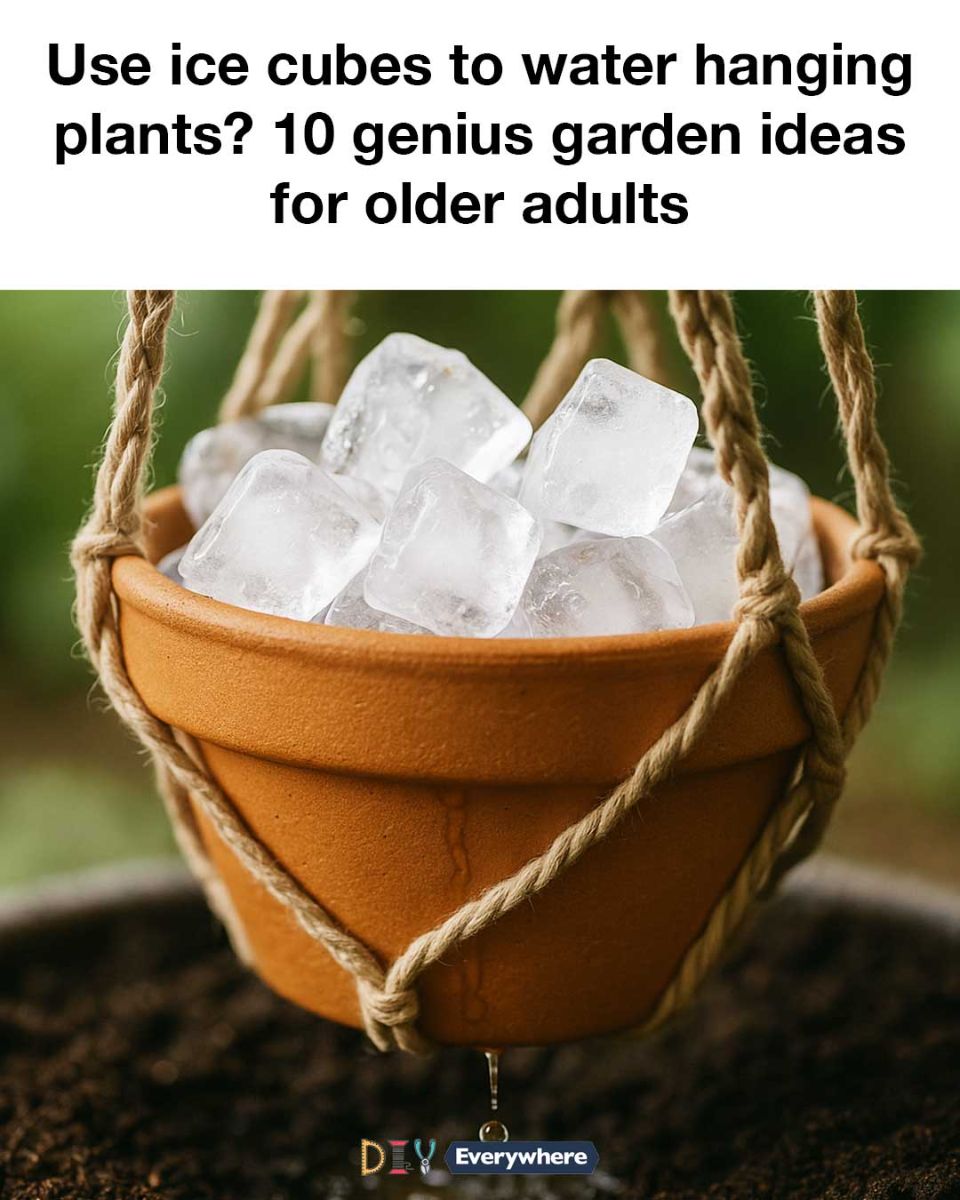Gardening is a rewarding hobby that offers numerous physical and mental health benefits, especially for older adults. However, as we age, certain gardening tasks can become more challenging due to physical limitations. Fortunately, there are many innovative techniques and tools that can make gardening more accessible and enjoyable for older adults.
In this article, we explore ten genius garden ideas that cater to the needs of older adults, ensuring they can continue to enjoy their passion for gardening with ease and comfort. From using ice cubes to water hanging plants to incorporating smart technology for garden management, these ideas are designed to simplify gardening tasks and enhance the overall experience.
1. Ice Cubes for Slow Watering
Using ice cubes to water hanging plants is a clever solution for older adults who may find it difficult to reach high or awkwardly placed planters. By placing a few ice cubes on the soil surface, the water is released slowly as the ice melts, allowing for gradual absorption by the plant’s roots. This method not only prevents overwatering but also ensures that the plant receives a steady supply of moisture.
For optimal results, use 2-3 ice cubes per small hanging plant and adjust the number based on the size of the planter. This technique is particularly useful for plants that prefer consistent moisture levels, such as ferns and begonias.
2. Raised Garden Beds for Easy Access
Raised garden beds are an excellent option for older adults who may have difficulty bending or kneeling. These elevated planters can be built at a height that is comfortable for standing or sitting, reducing strain on the back and knees. A typical raised bed is about 2-3 feet high, but the height can be adjusted to suit individual needs.
In addition to accessibility, raised beds offer better soil drainage and can be filled with high-quality soil, promoting healthier plant growth. They also help keep pests at bay and can be designed with built-in seating for added convenience.
3. Self-Watering Planters
Self-watering planters are a fantastic solution for older adults who may forget to water their plants regularly or have difficulty carrying heavy watering cans. These planters have a built-in reservoir at the bottom that supplies water to the plant’s roots through capillary action. This ensures that the plant receives a consistent supply of moisture without the need for frequent watering.
To use a self-watering planter, simply fill the reservoir with water, and the planter will take care of the rest. These planters are available in various sizes and styles, making them suitable for both indoor and outdoor gardening.
4. Vertical Gardens to Save Space
Vertical gardens are an innovative way to maximize gardening space, especially for those with limited room or mobility issues. By growing plants on walls or trellises, older adults can enjoy a lush garden without the need for extensive bending or reaching.
Vertical gardens can be created using wall-mounted planters, hanging pockets, or stacked pots. They are ideal for growing herbs, small vegetables, and flowering plants. This method not only saves space but also adds a beautiful, green aesthetic to any area.
5. Lightweight Tools for Less Strain
see next page
Gardening is a rewarding hobby that offers numerous physical and mental health benefits, especially for older adults. However, as we age, certain gardening tasks can become more challenging due to physical limitations. Fortunately, there are many innovative techniques and tools that can make gardening more accessible and enjoyable for older adults.
In this article, we explore ten genius garden ideas that cater to the needs of older adults, ensuring they can continue to enjoy their passion for gardening with ease and comfort. From using ice cubes to water hanging plants to incorporating smart technology for garden management, these ideas are designed to simplify gardening tasks and enhance the overall experience.
1. Ice Cubes for Slow Watering
Using ice cubes to water hanging plants is a clever solution for older adults who may find it difficult to reach high or awkwardly placed planters. By placing a few ice cubes on the soil surface, the water is released slowly as the ice melts, allowing for gradual absorption by the plant’s roots. This method not only prevents overwatering but also ensures that the plant receives a steady supply of moisture.
For optimal results, use 2-3 ice cubes per small hanging plant and adjust the number based on the size of the planter. This technique is particularly useful for plants that prefer consistent moisture levels, such as ferns and begonias.
2. Raised Garden Beds for Easy Access
Raised garden beds are an excellent option for older adults who may have difficulty bending or kneeling. These elevated planters can be built at a height that is comfortable for standing or sitting, reducing strain on the back and knees. A typical raised bed is about 2-3 feet high, but the height can be adjusted to suit individual needs.
In addition to accessibility, raised beds offer better soil drainage and can be filled with high-quality soil, promoting healthier plant growth. They also help keep pests at bay and can be designed with built-in seating for added convenience.
3. Self-Watering Planters
Self-watering planters are a fantastic solution for older adults who may forget to water their plants regularly or have difficulty carrying heavy watering cans. These planters have a built-in reservoir at the bottom that supplies water to the plant’s roots through capillary action. This ensures that the plant receives a consistent supply of moisture without the need for frequent watering.
To use a self-watering planter, simply fill the reservoir with water, and the planter will take care of the rest. These planters are available in various sizes and styles, making them suitable for both indoor and outdoor gardening.
4. Vertical Gardens to Save Space
Vertical gardens are an innovative way to maximize gardening space, especially for those with limited room or mobility issues. By growing plants on walls or trellises, older adults can enjoy a lush garden without the need for extensive bending or reaching.
Vertical gardens can be created using wall-mounted planters, hanging pockets, or stacked pots. They are ideal for growing herbs, small vegetables, and flowering plants. This method not only saves space but also adds a beautiful, green aesthetic to any area.
5. Lightweight Tools for Less Strain
see next page

